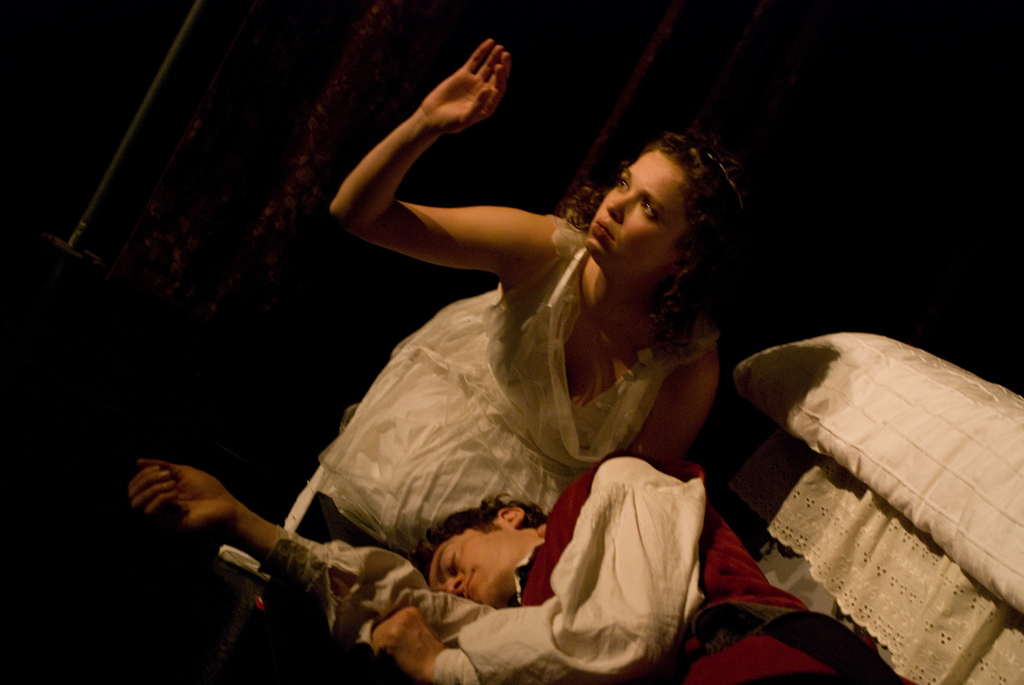I love Shakespeare’s comedies. Most of the tragedies leave me cold, though, because the protagonist has a tragic flaw, or, more often than not, is a jerk, who deserves everything coming to him. But a few of the tragedies have extenuating circumstances.
King Lear, for instance, has lost touch with reality due to being surrounded by yes-men for most of his life. He’s been a workaholic king and thus an absent parent, so he really has no idea two of his kids are jerks. But he learns. He may be screwed, but he learns. I saw Brian Bedford’s wonderful Lear at the 2007 Stratford Shakespeare Festival a few years ago, but since the Festival doesn’t allow photographs, I can’t post any here.
What I can do is post this cool photograph which depicts the final scene of Shakespeare’s King Lear, rendered in sculpture on a floating platform on King Lear’s Lake, at Watermead Country Park in Leicester.
Photographed by Mat Fascione, this image has been released under a Creative Commons Attribution-ShareAlike 2.0 Generic (CC BY-SA 2.0) License. This license allows me the freedom to reuse the image in any way I like, including illustrating this article, as well as adjusting the colours and contrast as I have done here (click on the image, it will take you the original).
Another Shakespearean Tragedy that I like is Othello, because again, the title character isn’t a monster. In fact, Othello is actually a pretty good guy, but for strangling poor, innocent, Desdemona. Alright, I admit it: that’s a pretty big “but.” But powerful military leader or not, his friend and comrade Iago masterfully mined and manipulated his insecurities to bring on his downfall — and Desdemona’s. I don’t know about you, but I certainly know what insecurity is. I am a writer after all.
Richard Monette’s final season included a production of Othello that starred Philip Akin, the first time a black Canadian played the title role at the Canadian Stratford Festival. Restrictive copyright law prevents me from having a photograph to post, but, as often happens, Flickr came through with a photo licensed for reuse by Shehal Joseph.
But the Shakespearean tragedy I like above all others is Romeo and Juliet. This tragic pair is only guilty of youth and lack of life experience. Admittedly, Romeo is a bit of an airhead, possibly even a twit, but Juliet is a passionate young woman who is only guilty of being true to herself.
The title of my debut novel is “Inconstant Moon” because of this passage:
O, swear not by the moon!
The inconstant moon,
that monthly changes in her circled orb,
lest that thy love prove
likewise variable.”— Juliet
William Shakespeare’s
Romeo & Juliet
The first time I heard these words spoken aloud was in the Zefirelli film when Olivia Hussey played Juliet. And I was blown away. Granted, at the time I was only a little older than Juliet, but I was floored that she had the presence of mind to so skilfully question Romeo’s motives and honesty with such beautiful language.
The story in my novel has been simmering in the back of my mind since I went to college, rather a few years back. I could never find the key to make it all fit together until now. After I had decided to try my hand at NaNoWriMo, although I never remember my dreams, I woke up the morning with the key that allowed the story out of my head and onto the page.
Juliet’s symbolic “inconstant moon” was the perfect metaphor for the novel’s dual themes of honesty and trust. Very often, the lessons we learn of who to trust are often among the hardest we learn in life.
Including part of this very scene as the play is performed in the background
When Liz makes her unfortunate discovery it is against a backdrop of this very scene being performed by a mythical company of players visiting the college. And of course, since Mr. Shakespeare’s immortal words are safely in the public domain, I was able incorporate them into the text without having to worry about defending against allegations of copyright infringement.
Since MIT hosts the works of Shakespeare online, finding the bits I needed was a simply matter of search, copy and paste. Well, I had to do a bit of my own writing as well, but I think it worked out quite well 🙂
Huzzah!
Image Credits
The final scene of Shakespeare’s King Lear has been rendered in sculpture on a floating platform on King Lear’s Lake, Watermead Country Park Leicester. Photographed by Mat Fascione and released under a Creative Commons Attribution-ShareAlike 2.0 Generic (CC BY-SA 2.0) License
Othello portrait by Shehal Joseph under a Creative Commons Attribution 2.0 Generic (CC BY 2.0) License
The scene from “The Most Excellent and Lamentable Tragedy of Romeo and Juliet“, was photographed at the Chopin Theatre, Chicago, December, 2008, by Paul Morgan and released under a Creative Commons Attribution-NonCommercial-NoDerivs 2.0 Generic (CC BY-NC-ND 2.0) License
The scene from Romeo and Juliet was photographed by Paul Morgan and released under a Creative Commons Attribution-NonCommercial-NoDerivs 2.0 Generic (CC BY-NC-ND 2.0)



Leave a Reply